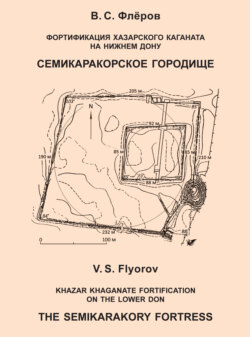Описание книги
Семикаракорское городище – кирпичная крепость, крупнейшая среди кирпичных и каменных крепостей Хазарского каганата в бассейне р. Дон, Ростовская обл. Первые раскопки крепости провел автор в 1971-1974 гг. Крепость площадью 4 га сооружена по схеме «квадрат в квадрате» из сырцового кирпича с долей обожженного, без угловых башен, но с грандиозным донжоном. Основной объем книги отведен строительным материалам и технологии кирпичного строительства, методике раскопок сырцовых стен. Полной неожиданностью стало открытие в Цитадели строений из обожженного кирпича. Для кровли применена черепица византийских типов, аналоги которым автор нашел в музеях Крыма и Болгарии. Анализ стратиграфии привел к выводу о кратковременном существовании крепости. Погибла при штурме; найдены останки убитых женщин и детей. Ряд данных позволяют синхронизировать Семикаракорскую крепость с Правобережной Цимлянской и отнести к досаркелскому времени, к концу VIII – самому началу IX в. Совокупность фактов и наблюдений привела к выводу о назначении Семикаракорской крепости: ставка хазарских каганов на Нижнем Дону. Введение Семикаракорской крепости в научный оборот позволяет пересмотреть существующие представления об участия Византии в формировании хазарской фортификации. Со всей очевидностью встает вопрос о том, что миссия Петроны Каматира не была единственной. Для археологов, историков, преподавателей, студентов. The Semikarakory hillfort is a brick fortress, the largest among the brick and stone fortresses of the Khazar Khaganate in the Don basin (Rostov oblast). The first excavations of the fortress were carried out by the author in 1971-1974. The fortress, with an area of 4 hectares, was built of mudbricks, some of which were fired. It follows the “square in square” scheme without corner towers, but with a grand keep. The bulk of the book is concerned with the building materials and brick-building technology, as well as the methodology for excavating mudbrick walls. A complete surprise was the discovery of fired brick buildings in the Citadel. For the roof, Byzantine-type tiles were used; the author was able to find analogous tiles in museums of Crimea and Bulgaria. Stratigraphy analysis led to the conclusion that the fortress had a short life span. It was destroyed m an assault; the remains of violently killed women and children were found. The existing evidence makes it possible to synchronize the Semikarakory fortress with the Right-Bank Tsimlyanskaya fortress and attribute it to pre-Sarkel time, that is, late VIII to very early IX century. The publication of findings from the Semikarakory fortress will finally remove it from the category of unexplored and will fill the gap in our knowledge about the formation of a fortress network throughout the Khazar Khaganate. The introduction of the Semikarakory fortress into research allows us to reconsider the existing ideas about the role that Byzantium played in the build-up of Khazar fortifications. This clearly suggests that the mission of Petronas Kamateros was not the only one. This book will be of interest for archaeologists, historians, teachers and students.
